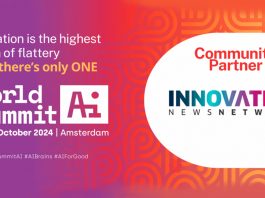As technology continues to rapidly advance, businesses need to navigate a balance between Innovation Myopia and Moonshot Innovation.
In an era when technology is evolving at an unprecedented pace, businesses are faced with a pivotal question: how do they balance the immediate gains from incremental innovation with the transformative potential of moonshot thinking?
AI and GenAI present unprecedented challenges and opportunities, affecting all industries and organisations simultaneously. Unlike past technological evolutions, which unfolded one industry at a time, AI’s impacts are immediate and universal, leaving little room for leaders to learn from others’ mistakes.
This new landscape necessitates a delicate balance between Innovation Myopia—prioritising near-term, incremental enhancements—and Moonshot Innovation, which seeks transformative, long-term breakthroughs and a culture that embraces failing.
Companies must adeptly navigate this dynamic, ensuring they integrate swift efficiency improvements with far-reaching, visionary initiatives to stay competitive and innovative.
Understanding Innovation Myopia
Innovation Myopia, inspired by Harvard professor Ted Levitt’s seminal ‘Marketing Myopia,’ reflects a prevalent leadership issue where the focus is narrow-sighted and predominantly on incremental improvements in quality and customer satisfaction.
This narrow viewpoint neglects broader, future-oriented questions essential for transformative success. Too many leaders define their business too narrowly concerning industry. Are you in railroading or transportation? In TV or entertainment?
Leaders, preoccupied with refining existing products and services, confined in a too narrowly defined industry, often overlook the larger picture—what the future holds and how they can influence it.
In today’s AI-driven landscape, this myopia becomes particularly perilous as rapid technological advancements demand not only immediate responses but also forward-thinking strategies.
By merely concentrating on small-scale enhancements, companies miss out on shaping the future and leveraging AI’s full potential, risking obsolescence in a dynamically evolving market.

Understanding Moonshot Innovation
Moonshot Innovation, in contrast to Innovation Myopia, is about pursuing radical, transformative change rather than mere incremental improvements. This approach involves addressing complex challenges and aiming for solutions that can drastically alter market landscapes or create entirely new ones.
By focusing on what could be rather than what is, companies can redefine their industries and lead the way in technological evolution. In the context of AI and GenAI, Moonshot Innovation translates into exploring groundbreaking projects and research that push the boundaries of what’s currently possible – and often fail.
Such ambitious endeavours not only fuel long-term growth but also inspire a culture of creativity and bold thinking. While risky, these moonshots can yield unparalleled rewards, propelling companies beyond the conventional to become pioneers of the future.
How to develop an adventurous mindset
Moonshot Innovation extends beyond mere projects—it embodies a mindset of venturing into spaces filled with exponential unknown-unknowns, territories never navigated. This approach is about testing possible inventions within realms of vast uncertainty and developing innovative solutions while embracing failures as stepping stones toward viable products or discoveries never before imagined.
In this culture, the failure rate is not merely an outcome but a key performance indicator (KPI), reflecting the journey toward groundbreaking achievements. In the AI and GenAI era, adopting this mindset means creating a laboratory for the future, where failing fast and learning quickly are integral to uncovering transformative technologies.
This shift from fearing failure to leveraging it as a pathway to discovery is essential for companies aiming to lead in uncharted technological landscapes.
How to balance short- and long-term innovations
In the AI and GenAI era, companies must create and capture value through new business models while balancing efficiency and effectiveness. This balance involves integrating AI-driven insights into existing operations to improve efficiency while simultaneously exploring new, AI-enabled markets and services for growth.
Leaders must navigate this dual path by fostering an environment that supports traditional business strengths and innovative ventures. Creating value in this context means leveraging AI to optimise current processes and customer experiences, thereby enhancing immediate profitability and operational excellence.
Capturing value, however, requires a forward-thinking approach to harness AI’s potential for creating entirely new products, services, and business models that meet emerging customer needs and market demands.
This dual focus ensures that firms not only survive but thrive by continually adapting and evolving within the fast-paced technological landscape. Companies must therefore cultivate a balanced innovation ecosystem, where AI-driven efficiencies are matched with bold, explorative initiatives in moonshot projects.
Success stories
There are many examples of companies successfully integrating AI to optimise operations while also pioneering in new market spaces.
For instance, Cognite, a software developer for the oil and gas industries, implements technology to improve industrial efficiency and Gelato, a platform that connects e-commerce businesses with local printing partners, leverages AI for global, on-demand printing solutions.
Autostore revolutionises warehousing with its automated storage and retrieval system, and Vipps simplifies financial transactions through its mobile payment app.
All of these companies have (at least) two things in common: They illustrate the power of combining operational enhancements with visionary projects and are unicorns. They also show the importance of adopting a dual focus, leveraging data for continuous improvement, and embracing risk in pursuit of transformative outcomes.
Looking to the future
In the dynamic era of AI and GenAI, where all industries and organisations are impacted simultaneously, businesses must adeptly balance operational efficiency (upstream innovation) with customer effectiveness (downstream innovation), including visionary Moonshot Innovations, to remain competitive.
To get to the future, organisations must survive today. Leaders should foster an environment that encourages experimentation and learning from failures while leveraging AI to enhance current processes and explore new market opportunities.
Embracing this dual approach paves the way for sustainable growth and innovation. AI and GenAI can be valuable in both the short term and the long term in all dimensions of invention (developing something useful and novel) and innovation (commercialising an invention).
But if we only employ the technology to do the same as we always have done, but with higher efficiency, we have gained little. We need to look for opportunities – moonshots – to create and capture value in ways we have previously never been able to do. Without customers, even the most productive and efficient firm is bankrupt.

© Stig B Fiksdal / DNB

© Odd Mehus









